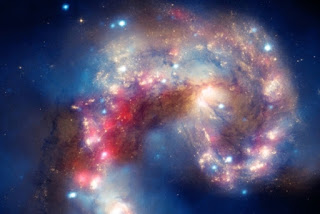 |
| Credit: NASA/CXC/SAO/J.DePasquale and NASA/JPL-Caltech and NASA/STScI |
Topics: Astrophysics, Big Bang, Cosmology, Science Fiction, Theoretical Physics
The next-to-last related topic may seem unrelated: one of the Marvel Comics I recall reading was "Origin of Galactus," nee Galan who in the rebirth of the previous universe became the devouring planet eater that the Fantastic Four would battle and enslave his herald The Silver Surfer. This wouldn't be possible without someone reading the scientific papers of the day, so this idea is not new. It doesn't have to be true, proven or compelling to exist as an effective plot device.
What most non-fans of comics never appreciated is the amount of research the writers did to create their stories. I recall for instance passing a history test on Norse Mythology solely on the info I'd gleaned from Thor comics, albeit the original Norse god was describe as red-haired, needing a power belt and gloves to lift Mjölnir, having a goat-drawn chariot; three wives and children. Probably too much to put on the big screen.
Did the universe start with a bang or a bounce—or something else entirely? The question of our origins is one of the thorniest in physics, with few answers and lots of speculation and strong feelings. The most popular theory by far is inflation, the notion that the cosmos blew up in size in the first few fractions of a second after it was born in a bang. But an underdog idea posits that the birth of this universe was not actually the beginning—that an earlier version of spacetime had existed and contracted toward a “big crunch,” then flipped and started expanding into what we see today. Now a new study suggesting a twist on this “bounce” scenario has supporters excited and inflation proponents newly inflamed over a “rival” they say they have repeatedly disproved, only to have it keep bouncing back.
Inflation has many admirers because the rapid expansion it posits seems to explain numerous features of the universe, such as the fact that it appears relatively flat (as opposed to curved, on large scales) and roughly uniform in all directions (there is roughly the same amount of stuff everywhere, again on large scales). Both conditions result when regions of space that ended up very far away initially started out close together and in contact with one another. Yet the latest versions of the theory seem to suggest—even require—that inflation created not just our universe but an infinite landscape of universes in which every possible type of universe with every possible set of physical laws and characteristics formed somewhere. Some scientists like this implication because it could explain why our particular universe, with its seemingly random yet perfectly calibrated-to-life conditions, exists—if every type of cosmos is out there, it is no wonder that ours is, too. But other physicists find the multiverse idea repulsive, in part because if the theory predicts that every possibility will come to pass, it does not uniquely foretell a universe like the one we have.
“Big bounce” theories also predict a flat and uniform cosmos, thanks to smoothing-out effects on space that can take place during the contraction. But the sticking point of the bounce idea has long been the transition between shrinking and expanding, which seemed to require the much-hated idea of a “singularity”—a time when the universe was a single point of infinite density—seen by many as a mathematically meaningless proposition that indicates a theory has gone off the rails. Now physicists say they have found a way to calculate the bounce without encountering any singularities. “We found we could describe the quantum evolution of the universe exactly,” says study co-author Neil Turok, director of the Perimeter Institute for Theoretical Physics in Ontario. “We found that the universe passes smoothly through the singularity and out the other side. That was our hope, but we’d never really accomplished this before.” He and Steffen Gielen of Imperial College London published their calculations last month in Physical Review Letters.
Scientific American: Did the Universe Boot Up with a “Big Bounce?” Clara Moskowitz
Comments